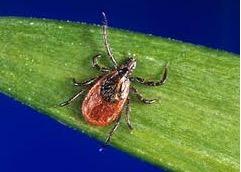
I may be pathogenically biased, but in the world of germs, nothing is more frightening than viruses. (See Steve Schow: "The Next Plague - Viruses: The Superstars Among Pathogenic Plague Microbes," but only if you want to scare the hell out of yourself.)
With warm weather on the way, we will need to be aware of the usual suspects transmitted by ticks (like the bacterium that causes Lyme disease, Borrelia burgdorferi) and by mosquitoes (like the virus that causes West Nile). These are nasty enough, but there is a bad boy out there that makes them look like creamed spinach. Meet the Powassan virus (1). It is pure evil. (Figure 1)

Figure 1: Electron microscopy image of Powassan. Photo: Canadian Medical Association Journal
The good news (make that the only good news) is that the virus is very rare in this country (Figure 2). So rare, that it is not worth worrying about at this time, even though a five-month old boy recently made the news by contracting the infection, which made him very ill. Lyme (about 25,000 cases per year) and Rocky Mountain Spotted Fever (RMSF -- caused by the bacterium Rickettsia rickettsii -- about 2,000), both tick-borne, are far bigger concerns.

Figure 2: Cases of neuroinvasive Powassan by year Source: CDC
The number of cases nationwide is very low, however, these statistics cannot directly be compared to those of Lyme or RMSF, because Figure 2 shows only the reportable cases—those that have caused neurological disease, which must be reported to the CDC. Although miniscule, the risk is not zero, and the CDC indicates that the number of cases is rising.
This trend can be seen in Maine, where the virus killed one woman in 2013. Figure 3 shows the results of a study conducted by the Maine Medical Center Research Institute. The "tick group" collected both adult and nymph deer ticks (the same tick that carries Lyme) from 30 towns in the state between June 2015 and December 2016. Depending on location, up to 16 percent of deer ticks were found to be infected with the virus.

Figure 3: Percentage of pools of deer ticks testing positive for Powassan in 11 Maine counties. Source: Maine Medical Center Research Institute.
The bad news is that the neurological disease is severe - sometimes even fatal. The severity becomes evident upon reading the case study in the April 21, 2017 MMWR (2).
- "In early November 2016, a previously healthy male infant aged 5 months from eastern Connecticut developed fever and vomiting. Right-sided facial twitching began over the next several days, and progressed to seizures that included rightward eye deviation and right arm stiffening."
- "Magnetic resonance imaging (MRI) of the brain showed a symmetric pattern... [that was] consistent with encephalitis."
- "One month after the onset of symptoms the parents noted that he could no longer sit up unaided, a milestone that he had met prior to the illness. Four months after his illness (aged 10 months), he was reported to have normal motor and verbal development (crawling, walking with a walker, and babbling)."
- A second MRI performed 4 months after the first revealed gliosis and encephalomalacia in the thalami and basal ganglia bilaterally, with volume loss and evidence of early mineralization in the left basal ganglia [permanent brain damage].
Both the severity of neurological symptoms and the estimated mortality rate (5-10 percent) demonstrate that this is not something you want to catch. In contrast to Lyme, if you are bitten by an infected tick, Powassan is easy to catch. Conventional wisdom about Lyme says that the tick must be attached for 24-48 hours (3) for infection to take place, but Powassan can be transmitted within an hour.
So, you shouldn't do anything more than what you're already doing to protect yourself. Stay out of the bushes and high weeds. If you must go in, wear light colored clothing (long sleeves and pants), tuck the pants into your socks, and use a repellant like DEET. Or maybe spray your property with a pesticide like Anvil. This kills both ticks and mosquitoes. Hopefully Powassan will never become part of your vocabulary.
Notes
(1) The name is derived from the town Powassan, Ontario, where it was first identified in 1958. Powassan is a flavivirus, which is in the same family of viruses that includes hepatitis C, yellow fever, Zika, and Dengue.
(2) MMWR is short for Morbidity and Mortality Weekly Report, a weekly CDC publication.
(3) This figure is still controversial.



